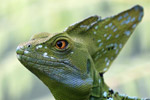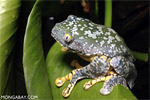People from local communities may provide information on area wildlife that is as accurate, cheaper than traditional scientific assessments
Figuring out what species live in a given area is important to the determination of its conservation importance. Traditionally, these biodiversity assessments have been done directly by scientists via surveys, which can be very time-intensive and expensive. However, a new study published recently in Conservation Letters found that interviewing people in local communities who are familiar with the species of their regions could be just as effective – and much cheaper.
The study, co-authored by Finn Danielsen, an ecologist who works with the Nordic Foundation for Development and Ecology, connects indigenous and western scientific knowledge for biodiversity assessments through the use of focus groups. Bringing together these two sources of knowledge is a goal of the Intergovernmental Platform on Biodiversity and Ecosystem Services (IPBES), whose overall aim is to evaluate the earth’s environment and recognize changes over time.
The study took place in the Bosawás Biosphere Reserve in Nicaragua, home to many species such as harpy eagles (Harpia harpyja). Photo by Rhett A. Butler.
To test the usefulness of interviewing local people for data collection, the researchers visited Miskito and Mayangna communities that reside in the Bosawás Biosphere Reserve in Nicaragua, an area regarded as a conservation focal point because of its rich biodiversity. Local community members took part in focus group discussions concerning the presence and abundances of plant, mammal and bird species.
The researchers then compared the focus group data to information collected in the field by trained scientists. The main difference between focus group and field data is that the former focused on qualitative data while the scientists collected quantitative data. The results, which were collected over a period of two years, showed that there were no significant differences between the results of the locals and the scientists, while the focus group method proved to be eight times cheaper.
As well as participating in focus groups, local community members also partook in line transect routes laid out by scientists. They walked these routes on different days than the researchers, but used the same pace and length. The locals who paced these routes every three months were carefully selected by village leaders based on their experience and interest; visual observations, tracks, feces, and sounds of the animals were recorded. Although results were somewhat similar between both groups, local people consistently counted higher numbers of animals than did the trained scientists.

Focus group meeting in session in San Andres. Photo by Sune Holt.
According to Danielsen, the scientific community has previously dismissed contributions from local people, regarding it as largely unreliable “anecdotal information.” However, “when scientists survey the biodiversity of an area, they often begin by asking the indigenous and local communities what species there are and where they are found,” since often these communities depend on these natural resources and species for their survival and may therefore be more knowledgeable.
Danielsen said he and his colleagues “were very surprised that the focus group findings matched both the community members’ transect results and the scientists’ transect results so well. Just by living in the area and observing their environment on a day-to-day basis, indigenous and local communities can have a very detailed knowledge about the abundance of the resources.”
 A local indigenous hunter from the Miskiti tribe noting his observations on a line transect route. Poto by Sune Holt. |
The question that remains is if focus groups will or could ever be implemented on a more global basis. Danielsen emphasized the importance of needing a strong network of facilitators to be able to encourage dialogue between community members, as well as facilitating focus groups and training others to do the same.
“If community members can undertake biodiversity assessments and find the same results as scientists, it may be possible for community members to have a more profound role in biodiversity assessments,” he said, “and this may have the important added benefit that it may create a direct link between the assessments and the management of the area.”
Not only are these results important in demonstrating that indigenous and local knowledge is a reliable source of information for biodiversity assessments, but they may also help promote positive relationships between the local communities and scientists. In addition, the use of focus groups could be a proficient, cost-effective way of aiding the increasing demand for environmental intelligence, and provide for better resource management.
“Community leaders and people regularly discuss the availability and quality of natural resources. In this way, they control and monitor access to certain areas and the use of species and resources… IPBES and other efforts to monitor biodiversity and natural resources may be designed to build upon and strengthen such existing community-based monitoring,” Danielsen said.

Chart from Danielsen et al. comparing the cost breakdowns of the different biodiversity assessment methods studied.
Citations:
- Danielsen, F., Jensen, P. M., Burgess, N. D., Coronado, I., Holt, S., Poulsen, M. K., Rueda, R. M., Skielboe, T., Enghoff, M., Hemmingsen, L. H., Sørensen, M. and Pirhofer-Walzl, K. (2014), Testing focus groups as a tool for connecting indigenous and local knowledge on abundance of natural resources with science-based land management systems. Conservation Letters. doi: 10.1111/conl.12100
Related articles
Scientists catalog the world’s 10,000th reptile

(08/04/2014) As of this year, scientists have named and described over 10,000 reptiles, marking a new milestone in cataloging one of the most diverse vertebrate groups. Last week, the Reptile Database, an online catalog of all the world’s living reptiles, announced it had passed 10,000 species.
Ecologists are underestimating the impacts of rainforest logging

(07/31/2014) Ecologists may be underestimating the impact of logging in old-growth tropical forests by failing to account for subtleties in how different animal groups respond to the intensity of timber extraction, argues a paper published today in the journal Current Biology. The study, led by Zuzana Burivalova of ETH Zurich, is based on a meta-analysis of 48 studies that evaluated the impact of selective logging on mammals, birds, amphibians, and invertebrates in tropical forests.
87 new bird species considered threatened with extinction
-Endangered_copyright-Steve-Wilson.150.jpg)
(07/29/2014) Scientists have added 361 new bird species to the IUCN Red List following a major taxonomic review of non-passerine birds, i.e. non-perching or non-songbirds. Worryingly, 87 of these new birds are threatened with extinction, a percentage nearly double the overall threatened percentage for all birds, which currently sits at 13 percent.
Deforestation ramping up in Yasuni as Ecuador sets to open up national park to drilling

(07/29/2014) Yasuni National park has been in the conservation spotlight in recent years, with oil drilling threatening the forests and wildlife of this biodiversity hotspot. Recently, disturbance in the park may have ramped up, with satellite data showing a significant increase in deforestation alerts within Yasuni National Park since 2011.
It’s not just extinction: meet defaunation

(07/24/2014) Get ready to learn a new word: defaunation. Fauna is the total collection of animals—both in terms of species diversity and abundance—in a given area. So, defaunation, much like deforestation, means the loss of animals in all its myriad forms, including extinction, extirpation, or population declines.

(07/21/2014) After more than four and a half years of camera trap footage, the results are encouraging: 36 mammal species, of which more than half are legally protected, are prospering in this most surprising of spots: an oil palm plantation in the province of East Kalimantan in Indonesian Borneo.

(07/14/2014) The world’s grasslands are being destabilized by fertilization, according to a paper recently published in the journal Nature. In a study of 41 grassland communities on five continents, researchers found that the presence of fertilizer weakened grassland species diversity.